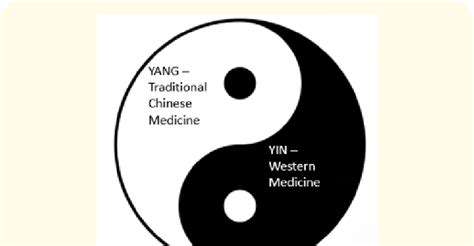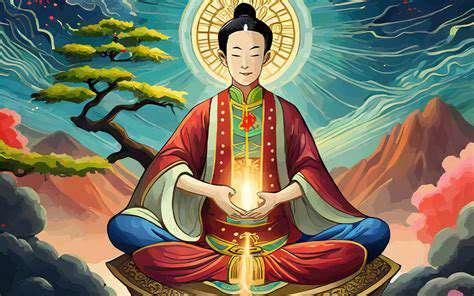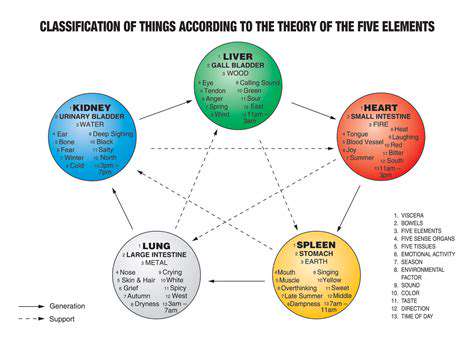
The Historical Context
Traditional Chinese medicine (TCM) boasts a rich and storied history, tracing its roots back millennia. Its development wasn't a sudden event, but rather a gradual accumulation of knowledge and practices passed down through generations. The philosophical underpinnings of TCM, emphasizing the interconnectedness of mind, body, and spirit, are deeply embedded in ancient Chinese thought. This holistic approach to health and well-being is a key differentiator from many Western medical models.
The Philosophical Basis
Central to TCM is the concept of Qi, a vital life force that flows through the body. Maintaining a balance of Qi is crucial for good health, and disruptions to this flow can lead to illness. Understanding the flow of Qi and its interaction with the body's various systems is fundamental to TCM diagnosis and treatment.
Another critical element is the theory of the five elements: wood, fire, earth, metal, and water. These elements are believed to interact with each other in cyclical patterns, reflecting the dynamic interplay within the body and the natural world. Recognizing these patterns allows practitioners to understand imbalances and tailor treatments accordingly.
The Role of Diagnosis
TCM diagnosis is multifaceted, encompassing a wide range of methods beyond the Western medical model. It involves a comprehensive assessment of the patient's overall condition, including their physical symptoms, emotional state, and lifestyle factors. Detailed observation, pulse diagnosis, and questioning are often used to understand the root cause of the imbalance.
Treatment Approaches
TCM treatment aims to restore balance and harmony within the body. This often involves a combination of techniques, including acupuncture, herbal medicine, and various forms of massage and exercise. Each treatment method is carefully selected based on the individual patient's needs and specific condition. This personalized approach to treatment is a hallmark of TCM.
Herbal Medicine
Herbal remedies play a significant role in TCM. A wide array of medicinal plants are used to address various ailments. These herbs are carefully selected and prepared according to specific formulas, often considering their specific properties and interactions. The preparation methods and dosages are crucial to achieving optimal therapeutic effects. The use of herbal remedies emphasizes a deep understanding of the properties of different plants and their effects on the body.
Acupuncture and Other Therapies
Acupuncture, a cornerstone of TCM, involves inserting thin needles into specific points on the body to stimulate the flow of Qi. This technique is believed to alleviate pain, reduce inflammation, and promote healing. Other TCM therapies, such as moxibustion (burning herbs near the skin) and gua sha (scraping the skin with smooth stones), also aim to restore balance and enhance well-being. These varied approaches offer a comprehensive therapeutic toolbox within the tradition.


The size of your roasting pan is crucial for achieving optimal results. A pan that's too small will overcrowd your food, leading to uneven cooking and potential steaming instead of browning. Conversely, a pan that's too large might distribute heat unevenly, resulting in some areas being undercooked while others are overcooked. Consider the quantity of food you're preparing and choose a pan that allows for adequate space between the items.
Beyond the Basics: Applying TCM Principles
Understanding Yin and Yang
The fundamental concept of Yin and Yang in Traditional Chinese Medicine (TCM) describes the interconnected and interdependent nature of opposing forces. Yin represents the receptive, passive, and often dark or cold aspects of life, while Yang embodies the active, assertive, and often bright or hot aspects. These forces are not absolute opposites but rather complementary aspects of a unified whole, constantly interacting and transforming into one another, like the ebb and flow of tides or the changing seasons.
Imagine a perfect circle, divided by a line. One side represents Yin, the other Yang. They are inseparable, existing only in relation to each other, and their balance is crucial for health and harmony. Disruptions in this balance can lead to imbalances within the body and the environment.
The Five Elements
Beyond Yin and Yang, the Five Elements – Wood, Fire, Earth, Metal, and Water – play a vital role in TCM's understanding of the body and its interactions with the environment. Each element possesses specific qualities and characteristics, and their interplay influences physical and emotional well-being. For instance, Wood, associated with growth and expansion, is linked to the liver and gallbladder, while Fire, representing transformation and activity, relates to the heart and small intestine.
Understanding the relationships between these elements helps TCM practitioners diagnose imbalances and tailor treatment plans to restore equilibrium. For example, if the Fire element is excessively active, potentially manifesting as irritability or insomnia, a treatment might focus on calming the Fire element by supporting the Water element, which acts as its counterbalance.
The Importance of Qi
Qi (pronounced chee) is a vital life force energy that flows throughout the body, nourishing and sustaining all functions. TCM views Qi as essential for physical, emotional, and spiritual well-being. Disruptions in the flow of Qi can lead to illness, pain, or emotional distress. Therefore, maintaining a healthy flow of Qi is paramount to good health.
Practitioners work to identify blockages in Qi flow and employ various techniques like acupuncture, herbal remedies, and Qigong to restore balance and promote the smooth circulation of this vital energy throughout the body. Understanding the concept of Qi is central to the philosophy and practice of TCM.
The Meridians and Acupuncture Points
TCM acknowledges a network of pathways throughout the body called meridians, which are believed to carry Qi. Acupuncture points are specific locations along these meridians that, when stimulated, can influence the flow of Qi, promoting balance and healing. The stimulation of these points can be achieved through the insertion of needles, or other techniques. These points are not just physical locations, but also energy junctions within the body.
Diagnosis and Treatment Methods
TCM practitioners employ a range of diagnostic methods, including pulse diagnosis, tongue observation, and patient interviews, to understand the root cause of an individual's imbalances. These methods provide insights into the state of Qi, blood, and other vital substances within the body. The holistic approach of TCM involves considering the patient's overall physical, emotional, and environmental factors when formulating a treatment plan.
These methods are used to determine the root cause of an imbalance, allowing for targeted treatments. These treatments might involve acupuncture, herbal medicine, dietary adjustments, and lifestyle recommendations, all tailored to the individual's specific needs and constitution.
The Role of Diet and Lifestyle
TCM emphasizes the profound connection between diet, lifestyle, and health. Appropriate foods are believed to nourish specific organs and promote the balance of Yin and Yang. Certain foods are considered warming, while others are cooling, and practitioners use this knowledge to suggest dietary adjustments to support the body's needs. This holistic approach extends beyond simply what you eat, encompassing activities like exercise, sleep, and stress management as crucial elements of maintaining health and well-being.
By understanding how diet affects Qi flow and the balance of Yin and Yang, individuals can actively participate in supporting their overall health and well-being, moving beyond a purely reactive approach to healthcare.